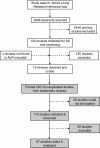Synthesising evidence for equity impacts of population-based physical activity interventions: a pilot study
- PMID: 23768212
- PMCID: PMC3706268
- DOI: 10.1186/1479-5868-10-76
Synthesising evidence for equity impacts of population-based physical activity interventions: a pilot study
Abstract
Background: This study applied an equity lens to existing research to investigate what is known about the impact of population-level physical activity interventions on social inequalities.
Methods: We performed a pilot systematic review to assess the availability of information on the social distribution of intervention effects, the targeting or allocation of interventions, and the baseline characteristics of participants. This comprised (i) a rapid review of systematic reviews and (ii) a review and synthesis of a sample of primary studies included in the eligible systematic reviews.
Results: We found 19 systematic reviews of environmental and policy interventions. Relatively few of these (26%, n=5) were prospectively designed to examine effects on inequalities, and none were able to fully synthesise evidence of distributional effects. Over 40% of primary studies reported subgroup intervention effects; 18% reported socio-demographic interaction effects. Studies most often compared effectiveness by gender, followed by age, ethnicity, and socio-economic status. For gender, effects appeared to be evenly distributed overall, although heterogeneity in gradients between studies suggested that some interventions affect males and females differently.
Conclusions: Our findings suggest that it is feasible to generate better evidence about how public health interventions may affect health inequalities using existing data and innovative methods of research synthesis.
Figures




References
-
- World Health Organization. Global recommendations on physical activity for health. Geneva: World Health Organization; 2010. - PubMed
-
- Department of Health. At least five a week: Evidence on the impact of physical activity and its relationship to health, a report from the Chief Medical Officer. London: Department of Health; 2004.
-
- Beenackers MA, Kamphuis CBM, Giskes K, Brug J, Kunst AE, Burdorf A, van Lenthe FJ, King T, Thornton L, Bentley R. Socioeconomic inequalities in occupational, leisure-time, and transport related physical activity among European adults: a systematic review. Int J Behav Nutr Phys Act. 2012;9(1):116. 110.1186/1479-5868-1189-1116. - PMC - PubMed
Publication types
MeSH terms
Grants and funding
LinkOut - more resources
Full Text Sources
Other Literature Sources
Medical

